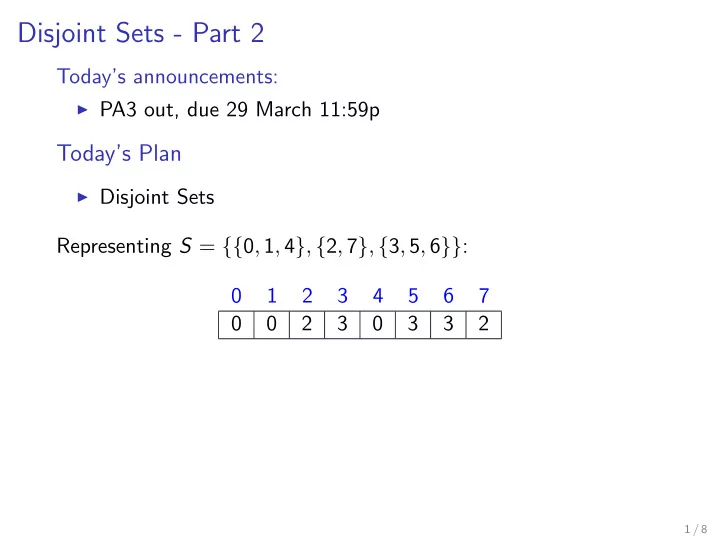

Disjoint Sets - Part 2 Today’s announcements: ◮ PA3 out, due 29 March 11:59p Today’s Plan ◮ Disjoint Sets Representing S = {{ 0 , 1 , 4 } , { 2 , 7 } , { 3 , 5 , 6 }} : 0 1 2 3 4 5 6 7 0 0 2 3 0 3 3 2 1 / 8
Disjoint Sets using UpTrees 0 2 3 8 S = {{ 0 , 1 , 4 } , { 2 , 7 } , { 3 , 5 , 6 } , { 8 }} 1 7 5 6 4 Find runtime depends on? int DS::Find( int k ) { if( parent[k] == k ) return k; else return Find( parent[k] ); } void Link(int root1, int root2) { parent[root__] = root__; } void DS::Union(int k1, int k2) { Link(Find(k1),Find(k2)); } 2 / 8
Smart Union 0 3 1 5 6 8 4 Union by height Choose root to minimize height. Union by size Choose root to minimize total depth. Following either scheme guarantees tree with n nodes has height: 3 / 8
Smart Union Code void LinkBySize(int root1, int root2) { if (size[root1] >= size[root2]) { parent[root2] = root1; size[root1] += size[root2]; } else { parent[root1] = root2; size[root2] += size[root1]; } } 0 3 1 5 6 8 4 4 / 8
Path Compression during Find int DS::Find( int k ) { if( parent[k] == k ) return k; else { parent[k] = Find( parent[k] ); return parent[k]; } } 3 Find(2) 3 5 6 8 1 4 2 5 6 8 7 1 4 7 2 5 / 8
Running time with smart union and path compression Iterated logarithm lg ∗ n � 0 if n ≤ 1 lg ∗ n = 1 + lg ∗ (lg n ) otherwise In other words, lg ∗ n is the number of times we can take lg iteratively until the result is at most 1. Example: lg ∗ (2 65536 ) = The number of atoms in the universe is estimated to be at most 2 273 . Theorem If m operations, either Union or Find, are applied to n elements, the total run time is O ( m lg ∗ n ) . Actually, O ( m α ( m , n )) is a better bound, where α ( m , n ) is the inverse Ackermann function, which grows verrrry slowly. 6 / 8
☜ ☜ ☜ ☜ ☜ ☜ ◀ Graphs bipartite ∩ unicyclic claw-free cactus 2-con K2-free SC 2-tree probe nected interval caterpillar ▼ partial grid ▼ 2-sub- bipartite probe cubic@ outer- Apollonian division@ ▶ interval planar network 2-tree ∩ tree binary planar 4-regu- bipartite tree deg ≤ 3 lar@ ▼ tolerance ∩ tree tree 2term planar … hamilt. Halin median@ E-free@ deg ≤ 4 ▽ C 4 -C 6 - C 8 -K 1,4 - series- odd cycle- parallel Laman free chordal@ 2-outer- planar bipartite@ domination perfect@ partial C 4 - 3-tree@ triangle- H n,q -grid unit… free k-outer- planar 2-con nected polyhedral lin. convex maximal C 4 -C 5 -K 4 - tr.grid planar diamond- graph homoth. locally bar free@ triangle strict triangle- odd-hole connected visibility B 1 -VPG free@ contact free@ ▼ contact solid … triang. gid grid graph deg ≤ 3 ▼ planar solid Planar Graphs relative … 2-strongly neighbor- regular@ hood grid graph strongly Gabriel ☜ graph class regular@ Urquhart ☜ class of bounded degree graphs label abbreviation class A@ class A ∩ planar graphs partial ☜ class of grid-like structured graphs grid class A ▼ class A ∩ unique ancestor ☜ class of trees class A ∩ left ancestor B class A ◀ B class A includes class B class A ▶ class A ∩ right ancestor A A class A… class A + name of the unique ancestor by Tamara Mchedlidze 7 / 8
Graphs 0 0 6 1 5 1 5 2 4 2 4 3 3 7406 divisible by 6 (or 7)? 1. Start at vertex 0 and leading digit. 2. At digit d , follow d black edges and then one red edge, and move to next digit. 3. Divisible by 6 (or 7) if end at vertex 0. 8 / 8
Recommend
More recommend